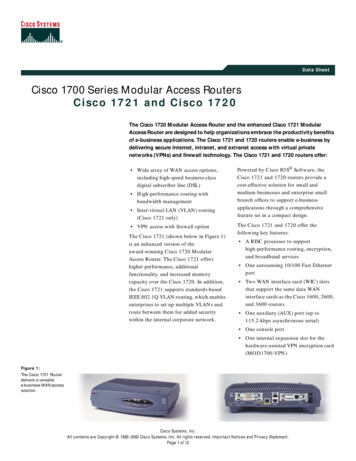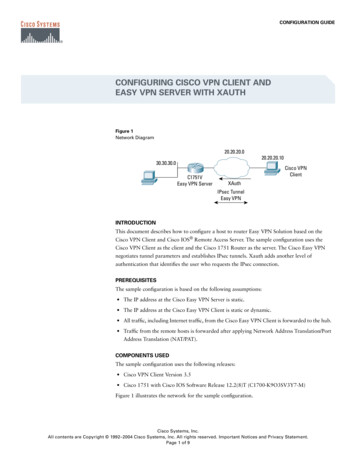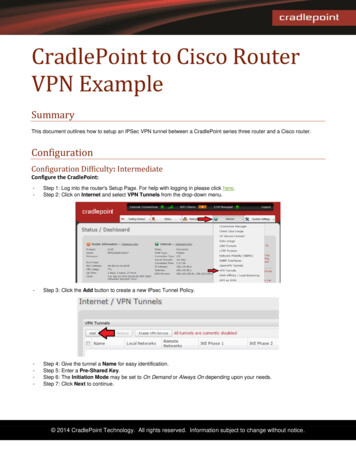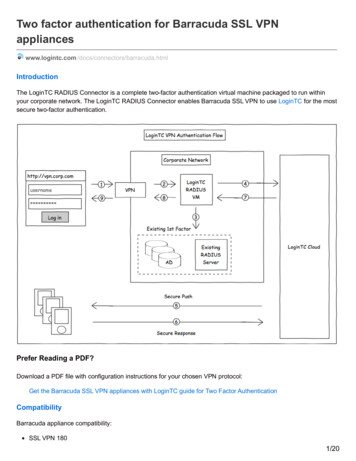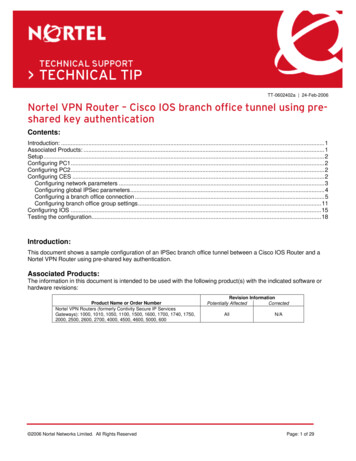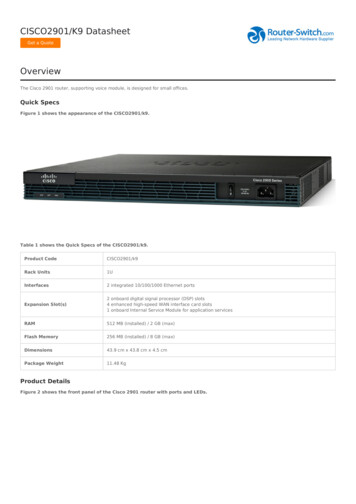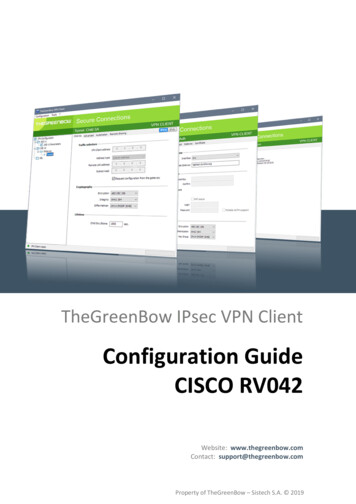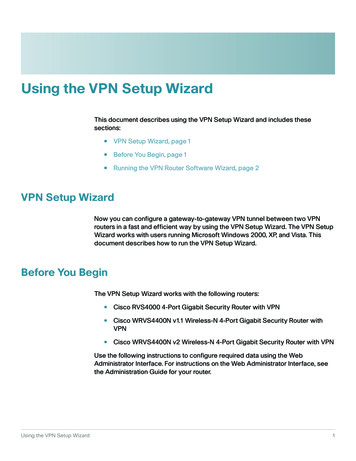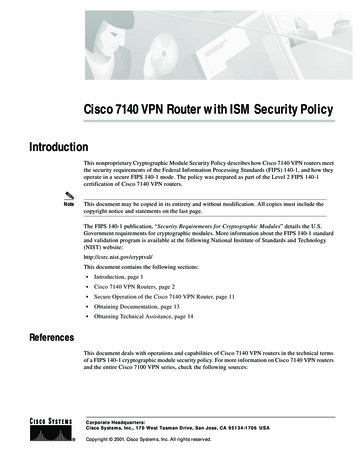
Transcription
Cisco 7140 VPN Router with ISM Security PolicyIntroductionThis nonproprietary Cryptographic Module Security Policy describes how Cisco 7140 VPN routers meetthe security requirements of the Federal Information Processing Standards (FIPS) 140-1, and how theyoperate in a secure FIPS 140-1 mode. The policy was prepared as part of the Level 2 FIPS 140-1certification of Cisco 7140 VPN routers.NoteThis document may be copied in its entirety and without modification. All copies must include thecopyright notice and statements on the last page.The FIPS 140-1 publication, “Security Requirements for Cryptographic Modules” details the U.S.Government requirements for cryptographic modules. More information about the FIPS 140-1 standardand validation program is available at the following National Institute of Standards and Technology(NIST) website:http://csrc.nist.gov/cryptval/This document contains the following sections: Introduction, page 1 Cisco 7140 VPN Routers, page 2 Secure Operation of the Cisco 7140 VPN Router, page 11 Obtaining Documentation, page 13 Obtaining Technical Assistance, page 14ReferencesThis document deals with operations and capabilities of Cisco 7140 VPN routers in the technical termsof a FIPS 140-1 cryptographic module security policy. For more information on Cisco 7140 VPN routersand the entire Cisco 7100 VPN series, check the following sources:Corporate Headquarters:Cisco Systems, Inc., 170 West Tasman Drive, San Jose, CA 95134-1706 USACopyright 2001. Cisco Systems, Inc. All rights reserved.
Cisco 7140 VPN Routers The Cisco Systems website contains information on the full line of Cisco Systems products. Referto the following website:www.cisco.com. The Cisco 7100 VPN Series product descriptions can be found at the following website:www.cisco.com/warp/public/cc/pd/rt/7100/ For answers to technical or sales related questions, please refer to the contacts listed on thefollowing website:www.cisco.com.TerminologyIn this document, the cryptographic module is referred to as the 7140 VPN router, the router, or the system.Document OrganizationThe security policy document is part of the complete FIPS 140-1 Submission Package. In addition to thisdocument, the complete submission package contains: Vendor evidence document Finite state machine Module software listing Other supporting documentation as additional referencesThis document provides an overview of Cisco 7140 VPN routers and explains the secure configurationand operation of the router. It also explains the general features and functionality of Cisco 7140 VPNrouters and addresses the required configuration for the FIPS mode of operation.NoteThis security policy and other certification submission documentation was produced by CorsecSecurity, Inc., under contract to Cisco Systems. With the exception of this nonproprietary securitypolicy, the FIPS 140-1 Certification Submission documentation is Cisco-proprietary and can bereleased only under appropriate nondisclosure agreements. For access to these documents, pleasecontact Cisco Systems.Cisco 7140 VPN RoutersCisco 7140 VPN routers provide superior routing and VPN services performance for the mostdemanding VPN deployments, as well as dual WAN interfaces and power supplies for increased VPNsolution reliability. Cisco 7140 VPN routers integrate key features of VPNs—tunneling, data encryption,security, firewall, advanced bandwidth management, and service-level validation—to deliverself-healing, self-defending site-to-site VPN platforms that better and more cost-effectivelyaccommodate remote-office and extranet connectivity using public data services.Cisco 7140 VPN routers offer specific hardware configurations and a processing architecture optimizedfor VPN applications and Customer Premises Equipment (CPE) environments, delivering turnkey VPNsolutions for headend locations. Cisco 7140 VPN routers feature integrated LAN interfaces forconnectivity to the corporate LAN or VPN termination behind the WAN edge, as well as optionalCisco 7140 VPN Router with ISM Security Policy2
Cisco 7140 VPN Routersmultiport WAN interfaces, providing multihomed connectivity to the VPN cloud. With its MIPS RISCprocessor, Cisco 7140 VPN routers deliver robust VPN features, such as bandwidth management andfirewall, at speeds greater than 90 Mbps, as well as scalable tunneling and encryption services.Cisco 7140 VPN routers are further customizable through hardware and software options toaccommodate diverse network architectures and requirements. An open expansion slot enablesLAN/WAN interface customization by utilizing a Cisco 7000 family port adapter. Highly scalabletunneling and encryption is provided by the Integrated Services Module (ISM), which is described laterin this document. With scalable support for IPSec, PPTP/MPPE, and L2TP, Cisco 7140 VPN routersprovide flexibility in remote access deployment models for enterprises with both remote access andsite-to-site VPN requirements. Advanced perimeter security and intrusion detection, key features in aself-defending VPN solution, are also provided on Cisco 7140 VPN routers via the Cisco IOS FirewallFeature Set.Cisco 7140 VPN routers are available in seven models. Key features common to all models include: High-speed MIPS RISC 7000 series processor, delivering superior routing performance and robustVPN features Greater than 90-Mbps throughput of VPN services such as bandwidth management and firewall 64-MB system memory for reliable, high-speed VPN services delivery—expandable to 256 MB 64-MB packet memory for advanced bandwidth management services and long-delay networks 48-MB Flash disk for storing Cisco IOS software images Dual autosensing 10/100BaseT Fast Ethernet ports, RJ-45 interfaces Integrated WAN interface Service module slot, providing a modular architecture for hardware-based VPN servicesacceleration, such as high-speed IPSec or MPPE encryption provided by the ISM One expansion slot for interface extensibility, utilizing over 30 Cisco port adapters, enablingLAN/WAN/voice interface customization for specific site requirements; this slot enables n x T1/E1WAN scalability up to 16 x T1 or 16 x E1 Dual PC card slots for loading and storing Cisco IOS configuration files from Flash disk or Flashmemory cards Console port for local terminal access, RJ-45 interface Auxiliary (AUX) port for asynchronous serial remote access, RJ-45 interfaceThe Cisco 7140 VPN Router Cryptographic ModuleThe metal casing that fully encloses the router establishes the router’s cryptographic boundary. All thefunctionality discussed in this document is provided by components within the casing. Cisco 7140 VPNrouters come equipped with two 280-Watt AC-input power supplies for power-load sharing and redundancy.Figure 1 shows the front of a Cisco 7140 router.Cisco 7140 VPN Router with ISM Security Policy3
Cisco 7140 VPN RoutersThe Cisco 7140 VPN Router18481Figure 1Cisco 7100 SERIESRouter Interfaces and LEDsThe interfaces are located on the back of the router. The rear panel LEDs shown in Figure 2 provide anoverall status of the router operation.Figure 2Rear Panel LEDsSystem LEDsACT ACTPWRAC OKDC OKReset buttonOTFPowersupplyLEDsSYSRDYLNK LNK01AC OKDC OKOTFRESETPWRACT ACTEN50FE 0 / 0ISLOT 1ENRXRX155 - MMTXENCEL CAR ALMFE 0 / 1RXLNK LNK01CONS155 - MMRXTXAUXAC OKSYSRDYDC OKOTF2CEL CAR ALM7140 - 2MM3SLOT 0SLOT 122058SM-ISMSLOT 0BOOTERRORSlot 0/1 LEDsTable 1 provides more detailed information conveyed by the LEDs on the rear panel of the router.Table 1Rear Panel LEDs and DescriptionsLEDIndicationDescriptionACT 0GreenIndicates 10BASE-T/100BASE-TX Ethernet ports aretransmitting or receiving packets.AmberIndicates 10BASE-T/100BASE-TX Ethernet ports haveestablished a valid link with the network. This LED remainsoff during normal operation of the router, unless there is anincoming carrier signal.GreenIndicates which PC Card slot is in use when either slot isbeing accessed by the system. These LEDs remain off duringnormal operation of the router.GreenIndicates that the power supply is delivering AC-input powerto the router.ACT 1LNK 0LNK 1Slot 0Slot 1PWRCisco 7140 VPN Router with ISM Security Policy4
Cisco 7140 VPN RoutersTable 1Rear Panel LEDs and Descriptions es the system is operational.AC OKGreenIndicates that AC input is within normal range.DC OKGreenIndicates that DC output is within normal range.OTFGreenIndicates that internal temperatures are normal.AmberIndicates a power supply fan failure.RDYThe Integrated Service Module (ISM) is a service module that resides in slot 5 in Cisco 7100 VPN seriesrouters. The ISM is a Layer 3 encryption service module that supports IP Security Protocol (IPSec)encryption of IP datagrams. In addition to enabling the secure use of public switched networks and theInternet through encryption, the ISM supports all encryption features supported by the Cisco IOSsoftware. The hardware-based services provided by the ISM improve the overall performance ofCisco 7100 VPN series routers by off-loading data encryption processing from the main systemprocessor.The ISM has one enabled LED and two status LEDs (see Figure 3). After system initialization, theenabled LED goes on to indicate that the ISM has been enabled for operation. If the initialization failsfor any reason, the enabled LED does not go on.Figure 3 shows the LEDs for the ISM Crypto Card with one enabled LED and two status LEDs.LEDs for ISM Crypto CardSM-ISMRESETBOOTERROREN23774Figure 3Refer to Table 2 for further description of the ISM LEDs.Cisco 7140 VPN Router with ISM Security Policy5
Cisco 7140 VPN RoutersTable 2ISM LEDs and es the ISM is powered up. After system initialization,the enabled LED goes on to indicate that power is receivedand that the ISM is enabled for operation. The followingconditions must be met before the enabled LED will go on: The ISM is correctly connected to the backplane and isreceiving power. The system bus recognizes the ISM.If either of these conditions is not met, or if the routerinitialization fails, the enabled LED does not go on.BOOTERRORAmberIndicates the ISM is booting. This amber LED remains onwhile the ISM is in the boot process or when a packet is beingencrypted or decrypted.Pulse AmberIndicates the ISM is operating. After successfully booting,the boot LED pulses in a "heartbeat" pattern to indicate thatthe ISM is operating. As crypto traffic increases, the nominallevel of this LED increases in proportion to the traffic level.AmberIndicates an error has occurred. This amber LED goes on toindicate that an error was found in either the encryptionfunction or the compression function. It is normally off.All of these physical interfaces are separated into the logical interfaces from FIPS as described inTable 3:Table 3FIPS 140-1 Logical InterfacesRouter Physical InterfaceFIPS 140-1 Logical InterfaceData Input Interface10/100BASE-TX LAN PortPort Adapter Interface ServiceModule InterfaceConsole PortAuxiliary Port*PCMCIA Slot*Data Output Interface10/100BASE-TX LAN PortPort Adapter Interface ServiceModule InterfaceConsole PortAuxiliary Port*PCMCIA Slot*Power SwitchConsole PortAuxiliary Port*Cisco 7140 VPN Router with ISM Security Policy6Control Input Interface
Cisco 7140 VPN RoutersTable 3FIPS 140-1 Logical Interfaces (continued)Router Physical InterfaceFIPS 140-1 Logical Interface10/100BASE-TX LAN PortLEDsStatus Output InterfacePwr LEDSys Rdy LEDConsole PortAuxiliary Port*Power PlugPower Interface* Disabled in FIPS mode. See “Secure Operation of the Cisco 7140 VPN Router” for more information.The module also has two other RJ-45 connectors for a console terminal for local system access and anauxiliary port for remote system access or dial backup using a modem. Additionally, Cisco 7140 VPNrouters have different physical interfaces available in the two fixed WAN ports.Table 4 gives a description of the Cisco 7140 VPN router series and physical interfaces.Table 4Cisco 7140 Routers Physical InterfacesRouterDescription of Physical InterfaceCisco 7140-2T3Provides two high-speed, synchronous serial ports that support full-duplexoperation at T3 (45-Mbps) speedsCisco 7140-2E3Provides two high-speed, synchronous serial ports that support full-duplexoperation at E3 (34-Mbps) speedsCisco 7140-2AT3Provides two high-speed, ATM ports that support full-duplex operation atT3 (45-Mbps) speedsCisco 7140-2AE3Provides two high-speed, ATM ports that support full-duplex operation atE3 (34-Mbps) speedsCisco 7140-2MM3Provides two ATM ports that support full-duplex operation atOC-3c/STM1 multimode (155-Mbps) speedsCisco 7140-8TProvides eight high-speed, synchronous serial ports that supportfull-duplex operation at T1 (1.544-Mbps) and E1 (2.048-Mbps) speedsCisco 7140-2FEProvides two fixed LAN ports —10BASE-T/100BASE-TX autosensingEthernet/Fast Ethernet (full and half duplex) equipped with an RJ-45receptacleFurther information about the different WAN options and their respective status indications (such asLED descriptions) can be found in the “Cisco 7100 Series VPN Router Product Overview” at thefollowing oduct/core/7100/hwicg/overegr.htmSlots in Cisco 7140 VPN routers are numbered as follows: Slot 0 - Fixed LAN (Ethernet) interface Slot 1 - Fixed WAN (serial) interfaceCisco 7140 VPN Router with ISM Security Policy7
Cisco 7140 VPN Routers Slot 2 - Fixed WAN (serial) interface Slot 3 - Not used Slot 4 - Modular port adapter Slot 5 - Service ModuleFigure 4 shows the slots in a Cisco 7140 VPN router.Figure 4Cisco 7140 Slot NumberingSlot 5Slot 4AC OKDC OKOTFRESETSLOT 1PWRACT ACTEN50FE 0 / 0IENRXRX155 - MMTXENCEL CAR ALMFE 0 / 1RXLNK LNK01155 - MMRXTXCEL CAR ALMSlot 1CONSAUXAC OKSYSRDYDC OKOTF27140 - 2MM318499SM-ISMSLOT 0BOOTERRORSlot 0 Slot 2Roles and ServicesThere are two main roles in the router (as required by FIPS 140-1) that operators can assume: cryptoofficer or administrator role and user role. The administrator of the router assumes the crypto officer rolein order to configure and maintain the router using crypto officer services, while the users exercise onlythe basic user services.This section also contains the following subsections: Cryptographic Officer Services, page 8 User Services, page 9Cryptographic Officer ServicesDuring initial configuration of the router, a cryptographic officer (crypto officer) password is definedand all management services are available from this role. The crypto officer connects to the routerthrough the console port through terminal program. A router administrator might assign permission todistribute the crypto officer role to additional accounts, thereby creating additional administrators.At the highest level, crypto officer services include the following: Configure the router: define network interfaces and settings, create command aliases, set theprotocols the router will support, enable interfaces and network services, set system date and time,load authentication information. Define rules and filters: create packet filters that are applied to user data streams on each interface.Each filter consists of a set of rules, which define a set of packets to permit or deny based oncharacteristics such as protocol ID, addresses, ports, TCP connection establishment, or packetdirection. Status functions: view the router configuration, routing tables, and active sessions; view SNMP MIBII statistics, health, temperature, memory status, voltage, and packet statistics; review accountinglogs, and view physical interface status.Cisco 7140 VPN Router with ISM Security Policy8
Cisco 7140 VPN Routers Manage the router: log off users, shut down or reload the router, manually back up routerconfigurations, view complete configurations, set manager user rights, restore router configurations. Set encryption/bypass: set up the configuration tables for IP tunneling. Set keys and algorithms tobe used for each IP range or allow plaintext packets to be set from specified IP addresses. Change port adapters: insert and remove adapters in a port adapter slot as described in “InitialSetup” section.User ServicesA user enters the system by accessing the console port with a terminal program. The IOS prompts theuser for their password. If it matches the plaintext password stored in IOS memory, the user is allowedentry to the IOS executive program. At the highest level, user services include the following: Status Functions: view state of interfaces, state of layer 2 protocols, version of IOS currentlyrunning Network Functions: connect to other network devices through outgoing telnet or PPP and initiatediagnostic network services (for example, ping, or mtrace) Terminal Functions: adjust the terminal session (that is, lock the terminal and adjust flow control) Directory Services: display directory of files kept in flash memoryPhysical SecurityThe router is entirely encased by a thick steel chassis. The back of the router provides one port adapterslot, one service module slot, on-board LAN connectors, PCMCIA slots, Console/Auxiliary connectors,the power cable connections, and the power switch.Once the router has been configured to meet FIPS 140-1 Level 2 requirements, the router cannot beaccessed without signs of tampering. To seal the system, apply serialized tamper-evidence labels asfollows: Clean the cover of any grease, dirt, or oil before applying the tamper evidence labels. Alcohol-basedcleaning pads are recommended for this purpose. The ambient air must be above 10C, otherwise thelabels may not properly cure. The tamper evidence label should be placed so that the one half of the tamper evidence label coversthe front panel of the router and the other half covers the enclosure (both the module cover andenclosure). The tamper evidence label should be placed over the cover for the Flash PC Card slots (next to thescrew on the underside) so that any attempt to open the Flash PC Card cover will show tamperevidence. The tamper evidence label should be placed so that the one half of the label covers the module andthe other half covers the service module slot. The tamper evidence label should be placed so that the one half of the label covers the enclosure andthe other half covers the port adapter slot.Cisco 7140 VPN Router with ISM Security Policy9
Cisco 7140 VPN Routers The tamper evidence label should be placed so that the one half of the label covers the enclosure andthe other half covers the slot cover to the left of the port adapter (Slot 3). The labels completely cure within five minutes.Figure 5 shows the tamper evidence label placements.Tamper Evidence Label Placement61226Figure 5Cisco 7100 SERIESESD receptacleModular port adapter61227Service moduleAC OKDC OKOTFSLOT 05SLOT 1ACT ACTPWRIE3ENRXTXRXFE 0 / 0FE 0 / 1E3CEL CAR ALMENRX0LNK LNK01TXRXCONSAUXSYSRDYAC OKDC OKOTFCEL CAR ALM27140 - 2AE3Fixed WAN port100-240Vac 50/60Hz5-2.5A 525WPC CardPower supplyslots (covered)Fixed LAN ports Console andauxiliary portsGroundingreceptaclesThe tamper evidence seals are produced from a special thin gauge vinyl with self-adhesive backing. Anyattempt to remove port adapters or service modules will damage the tamper evidence seals or the paintedsurface and metal of the module cover. Since the tamper evidence labels have nonrepeated serialnumbers, the labels can be inspected for damage and compared against the applied serial numbers toverify that the module has not been tampered with. Tamper evidence labels can also be inspected forsigns of tampering, which include the following: curled corners, bubbling, crinkling, rips, tears, andslices. The word “Opened” can appear if the label was peeled back.NoteIf possible, try to place the tamper evidence labels so that few of the ventilation holes are covered.Cryptographic Key ManagementThe router securely administers both cryptographic keys and other critical security parameters such aspasswords. The tamper evidence seals provide physical protection for all keys. Keys are also passwordprotected and can be zeroized by the crypto officer. Keys are exchanged manually and enteredelectronically via manual key exchange or Internet Key Exchange (IKE). The Cisco 7140 VPN routersupports the following FIPS-approved algorithms: DES, 3DES, and SHA-1. These algorithms receivedcertification numbers 74, 17, and 26 respectively.Cisco 7140 VPN Router with ISM Security Policy10
Secure Operation of the Cisco 7140 VPN RouterSelf-TestsIn order to prevent any secure data from being released, it is important to test the cryptographiccomponents of a security module to insure all components are functioning correctly. The router includesan array of self-tests that are run during startup and periodically during operations. The self-tests run atpower-up includes a cryptographic known answer test (KAT) on the FIPS-approved cryptographicalgorithms (DES, 3DES), on the message digest (SHA-1) and on the Diffie-Hellman algorithm. Alsoperformed at startup are a software integrity test using an EDC, and a set of Statistical Random NumberGenerator (RNG) tests. The following tests are also run periodically or conditionally: a bypass mode testperformed conditionally prior to executing IPSec, a software load test for upgrades, and the continuousrandom number generator test. If any of these self-tests fail, the router transitions into an error state.Within the error state, all secure data transmission is halted and the router outputs status informationindicating the failure.Secure Operation of the Cisco 7140 VPN RouterCisco 7140 VPN routers meet all the Level 2 requirements for FIPS 140-1. Follow the settinginstructions provided below to place the module in FIPS mode. Operating this router withoutmaintaining the following settings will remove the module from the FIPS approved mode of operation.This section contains the following topics: Initial Setup, page 11 System Initialization and Configuration, page 11 Non FIPS-Approved Algorithms, page 12 Protocols, page 12 Remote Access, page 13 The crypto officer must apply tamper evidence labels as described in the “Physical Security” sectionin this document. The crypto officer must securely store tamper evidence labels before use, and anytamper evidence labels not used should also be stored securely. Only a crypto officer can add and remove port adapters. When removing the tamper evidence label,the crypto officer should remove the entire label from the router and clean the cover of any grease,dirt, or oil with an alcohol-based cleaning pad. The crypto officer must reapply tamper evidencelabels on the router as described in the “Physical Security” section in this document.Initial SetupSystem Initialization and Configuration The crypto officer must perform the initial configuration. The IOS version shipped with the router,version 12.1(9)E, is the only allowable image. No other image can be loaded. The value of the boot field must be 0x0101 (the factory default). This setting disables the break fromthe console to the ROM monitor and automatically boots the IOS image. From the configureterminal command line, the crypto officer enters the following syntax:config-register 0x0101Cisco 7140 VPN Router with ISM Security Policy11
Secure Operation of the Cisco 7140 VPN Router The crypto officer must create the “enable” password for the crypto officer role. The password mustbe at least eight characters and is entered when the crypto officer first engages the enable command.The crypto officer enters the following syntax at the “#” prompt:enable secret [password] The crypto officer must always assign passwords (of at least eight characters) to users. Identificationand authentication of the console port is required for users. From the configure terminal commandline, the crypto officer enters the following syntax:line con 0password [password]login local The crypto officer shall only assign users to a privilege level 1 (the default). The crypto officer shall not assign a command to any privilege level other than its default. The Flash PC Card slot is not configured in FIPS mode. Its use is restricted via tamper evidencelabels (see the “Physical Security” section in this document).Non FIPS-Approved Algorithms The following algorithms are not FIPS approved and should be disabled:– RSA for encryption– MD-5 for signing– AH-SHA-HMAC– ESP-SHA-HMAC– HMAC SHA-1Protocols The following network services affect the security data items and must not be configured: NTP,TACACS , RADIUS, Kerberos. SNMP v3 over a secure IPSec tunnel can be employed for authenticated, secure SNMP Gets andSets. Since SNMP v2C uses community strings for authentication, only gets are allowed underSNMP v2C.Cisco 7140 VPN Router with ISM Security Policy12
Obtaining DocumentationRemote Access Auxiliary terminal services must be disabled, except for the console. The following configurationdisables login services on the auxiliary console line.line aux 0no exec Telnet access to the module is only allowed via a secure IPSec tunnel between the remote systemand the module. The crypto officer must configure the module so that any remote connections viatelnet are secured through IPSec.Obtaining DocumentationThe following sections provide sources for obtaining documentation from Cisco Systems.World Wide WebYou can access the most current Cisco documentation on the World Wide Web at the following sites: http://www.cisco.com http://www-china.cisco.com http://www-europe.cisco.comDocumentation CD-ROMCisco documentation and additional literature are available in a CD-ROM package, which shipswith your product. The Documentation CD-ROM is updated monthly and can be more current thanprinted documentation. The CD-ROM package is available as a single unit or as an annual subscription.Ordering DocumentationCisco documentation is available in the following ways: Registered Cisco Direct Customers can order Cisco Product documentation from the NetworkingProducts er root.pl Registered Cisco.com users can order the Documentation CD-ROM through the online tion Nonregistered Cisco.com users can order documentation through a local account representative bycalling Cisco corporate headquarters (California, USA) at 408 526-7208 or, in North America, bycalling 800 553-NETS(6387).Cisco 7140 VPN Router with ISM Security Policy13
Obtaining Technical AssistanceDocumentation FeedbackIf you are reading Cisco product documentation on the World Wide Web, you can submit technicalcomments electronically. Click Feedback in the toolbar and select Documentation. After you completethe form, click Submit to send it to Cisco.You can e-mail your comments to bug-doc@cisco.com.To submit your comments by mail, use the response card behind the front cover of your document, orwrite to the following address:Attn Document Resource ConnectionCisco Systems, Inc.170 West Tasman DriveSan Jose, CA 95134-9883We appreciate your comments.Obtaining Technical AssistanceCisco provides Cisco.com as a starting point for all technical assistance. Customers and partners canobtain documentation, troubleshooting tips, and sample configurations from online tools. For Cisco.comregistered users, additional troubleshooting tools are available from the TAC website.Cisco.comCisco.com is the foundation of a suite of interactive, networked services that provides immediate, openaccess to Cisco information and resources at anytime, from anywhere in the world. This highlyintegrated Internet application is a powerful, easy-to-use tool for doing business with Cisco.Cisco.com provides a broad range of features and services to help customers and partners streamlinebusiness processes and improve productivity. Through Cisco.com, you can find information about Ciscoand our networking solutions, services, and programs. In addition, you can resolve technical issues withonline technical support, download and test software packages, and order Cisco learning materials andmerchandise. Valuable online skill assessment, training, and certification programs are also available.Customers and partners can self-register on Cisco.com to obtain additional personalized information andservices. Registered users can order products, check on the status of an order, access technical support,and view benefits specific to their relationships with Cisco.To access Cisco.com, go to the following website:http://www.cisco.comCisco 7140 VPN Router with ISM Security Policy14
Obtaining Technical AssistanceTechnical Assistance CenterThe Cisco TAC website is available to all customers who need technical assistance with a Cisco productor technology that is under warranty or covered by a maintenance contract.Contacting TAC by Using the Cisco TAC WebsiteIf you have a priority level 3 (P3) or priority level 4 (P4) problem, contact TAC by going to the TACwebsite:http://www.cisco.com/tacP3 and P4 level problems are defined as follows: P3—Your network performance is degraded. Network functionality is noticeably impaired, but mostbusiness operations continue. P4—You need information or assistance on Cisco product capabilities, product installation, or basicproduct configuration.In each of the above cases, use the Cisco TAC website to quickly find answers to your questions.To register for Cisco.com, go to the following website:http://www.cisco.com/register/If you cannot resolve your technical issue by using the TAC online resources, Cisco.com registered userscan open a case online by using the TAC Case Open tool at the following g TAC by TelephoneIf you have a priority level 1 (P1) or priority level 2 (P2) problem, contact TAC by telephone andimmediately open a case. To obtain a directory of toll-free numbers for your country, go to the 687/Directory/DirTAC.shtmlP1 and P2 level problems are
Cisco 7140 VPN Router with ISM Security Policy Cisco 7140 VPN Routers * Disabled in FIPS mode. See “Secure Operation of the Cisco 7140 VPN Router” for more information. The module also has two other RJ-45 connectors for a console terminal for local system access and an auxiliary po


